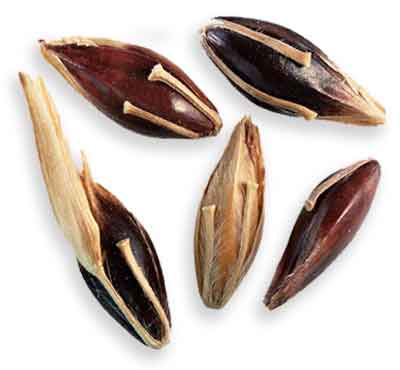
Family • Poaceae
Batad-batadan
Aroro
Sorghum halepense (L.) Pers.
ALEPPO MILLET GRASS / JOHNSON GRASS
Shi mao
| Scientific names | Common names |
| Andropogon avenaceus Kunth | Aroro (Bikol) |
| Andropogon crupina (Link) Kunth | Baku (Ifugao) |
| Andropogon decolorans (Willd.) Kunth | Batad-batadan (Tagalog) |
| Andropogon dubitatus Steud. | Ngigai (Tagalog) |
| Andropogon dubius K.Koch ex B.D.Jacks | Aleppo grass (Engl.) |
| Andropogon halepensis (L.) Brot. | Aleppo millet grass (Engl.) |
| Andropogon halepensis subsp. anatherus Piper. | Alwyn grass (Engl.) |
| Andropogon halepensis var. effusus Stapf | Evergreen millet (Engl.) |
| Andropogon halepensis var. muticus (Hack.) Asch. & Graebn. | Johnson grass (Engl.) |
| Andropogon miliaceus Roxb. | |
| Andropogon miliformis Schult. | |
| Andropogon sorghum subsp. exiguus (Forssk.) Piper | |
| Andropogon sorghum subvar. genuinus Hack. | |
| Andropogon sorghum subsp. halepense (L.) Hack. | |
| Andropogon sorghum var. halepensis (L.) Hack. | |
| Andropogon sorghum subsp. halepensis (L.) Hack. | |
| Andropogon sorghum subvar. leiocladus Hack. | |
| Andropogon sorghum subvar. muticus Hack. | |
| Andropogon sorghum var. perennis Bertoni | |
| Andropogon sorghum subvar. trachycladus Hack. | |
| Andropogon tumbackianus Roxb. ex Kunth | |
| Blumenbachia halepensis (L.) Koeler | |
| Holcus decolorans Willd. | |
| Holcus exiguus Forssk. | |
| Holcus halepensis L. | |
| Milium halepense (L.) Cav. | |
| Rhaphis halepensis (L.) Roberty | |
| Sorghum halepense (L.) Pers. | |
| Sorghum halepense var. aristatum Goiran | |
| Sorghum halepense var. coloratum Goiran | |
| Sorghum halepense var. crupina (Link) Steud. | |
| Sorghum halepense var. genuinum Hack. | |
| Sorghum halepense var. lasiostachyum Goiran | |
| Sorghum halepense var. latifolium Willk. | |
| Sorghum halepense var. majus Goiran | |
| Sorghum halepense var. minus Goiran | |
| Sorghum halepense f. muticum (Hack.) C.E.Hubb. | |
| Sorghum halepense var. muticum (Hack.) Grossh. | |
| Sorghum halepense var. schreberi (Ten.) Nyman | |
| Sorghum halepense subvar. submuticum Rendle | |
| Sorghum miliaceum (Roxb.) Snowden | |
| Sorghum miliaceum var. parviscpiculum Snowden | |
| Sorghum sacharatum var. halepense (L.) Kuntze | |
| Sorghum schreberi Ten. | |
| Trachypogon avenaceus Nees. | |
| Sorghum halepense (L.) Pers. is an accepted species. KEW: Plants of the World Online | |
| Other vernacular names |
| CHINESE: Shi mao. |
| FRENCH: Herbe d'Alep, Herbe de Cuba, Sorgho, Sorgho d'Alep. |
| PAKISTAN: Baru. |
| PALAUAN: Mbangarnuis. |
| SINDHI: Gua. |
| SPANISH: Cañota, Grama china, Hierba Johnson, Milloca, Pasto Johnson, Sorgo de Aleppo, Sorgo maleza, Zacate Johnson. |
| URDU: Jangli jawar. |
| WEST BENGAL: Kala-mucha, Dig-dana, Digu-ghas |
Botany
Properties Constituents Toxicants Studies Availability |
October 2023
![]()
 |
| PHOTOS / ILLUSTRATIONS |
| IMAGE SOURCE: Johnson grass / Daniel Villafruela / CC BY-SA 4.0 / click on image to go to source page / image modified / Wikipedia |
| OTHER IMAGE SOURCE: Johnson grass (Sorghum halepense) spikelets / Copyright © Government of Canada / Non-commercial use / click on link or image to go to source page / Inspection.Canada |
| OTHER IMAGE SOURCE: Sorghum halepense / Forest & Kim Starr / CC BY 3.0 / click on image to go to source page / Wikipedia |
Additional
Sources and Suggested Readings |
• |
DOI: It is not uncommon for links on studies/sources to change. Copying and pasting the information on the search window or using the DOI (if available) will often redirect to the new link page. (Citing and Using a (DOI) Digital Object Identifier) |
| List of Understudied Philippine Medicinal Plants |
| New plant names needed The compilation now numbers over 1,300 medicinal plants. While I believe there are hundreds more that can be added to the collection, they are becoming increasingly difficult to find. If you know of a medicinal plant to suggest for inclusion, please email the info: local plant name (if known), any known folkloric medicinal use, scientific name (most helpful), and, if available, a photo. Suggestions are greatly appreciated. (G.Stuart) |
 |




